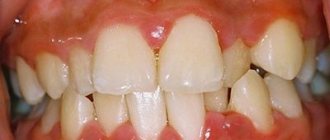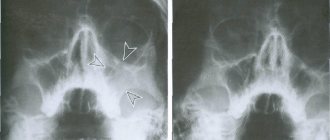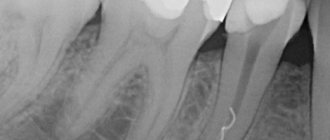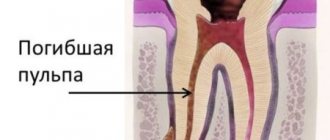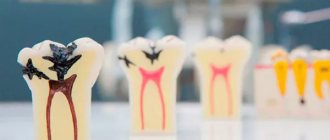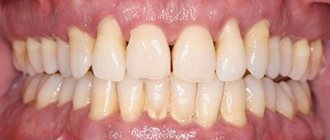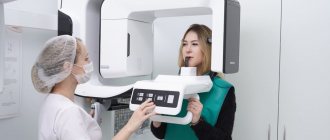We are publishing an article by Natalya Lvovna Mayorova, a dentist, therapist, head of the therapeutic department of the Dentalika clinic, St. Petersburg
The diagnosis of “periodontitis” is made when the periapical tissues of the roots of the tooth are damaged, which can be caused by infectious, toxic, allergic or traumatic factors. Often, several of these agents are simultaneously involved in the development of apical periodontitis.
The impact of infection on the periapical tissue is associated with the progression of the inflammatory process in the pulp and its destruction (decomposition).
Toxins that cause apical periodontitis are primarily microbial endotoxins and toxic substances formed during the decay of pulp tissue.
The cause of apical periodontitis can also be chemicals, solutions and medications, which usually do not cause damage to the peri-apical tissues or an inflammatory reaction. This occurs due to the special sensitivity of the body (sensitization) or not entirely correct use of drugs (exceeding the exposure time, removal beyond the root apex when used intracanally, etc.).
Apical periodontitis can be caused by trauma. Acute trauma is associated with a blow or bruise of a tooth, and the hard tissues of the tooth may not be damaged.
Injury to the peri-apical tissues is also possible when a root filling or pin is pushed past the apical hole. Typically, an acute injury leads to the development of acute apical periodontitis, and in the case of an already formed chronic process, to its exacerbation. Microtrauma of apical periodontitis can be associated with a filling, inlay or artificial crown, which forms a point of advance of the closure of the remaining teeth, with some anomalies in the position of the teeth, as well as with orthodontic treatment. Some habits occupy a special place in microtraumatic damage: biting thread, wire, biting a pencil, pen, etc.
Thus, according to the international classification, periodontal pathologies are divided into:
- Acute apical periodontitis (bacterial and non-bacterial etiology).
- Chronic apical periodontitis (practically asymptomatic).
- Chronic purulent apical periodontitis (the presence of a fistulous tract on the mucous membrane near the diseased tooth).
- Acute apical abscess (swelling and hyperemia (redness) of soft tissues are added).
The patient’s feelings and signs of the disease depend mainly on whether it is acute or chronic periodontitis.
With acute apical periodontitis, constant, intensifying pain of a pulsating nature appears, pain from the slightest touch to the tooth. The pain can spread to the entire half of the face. The gums and transitional fold may be hyperemic and swollen. Regional lymph nodes may become enlarged and tender to palpation. Possible facial asymmetry due to edema. In severe cases of acute purulent apical periodontitis, a pronounced general reaction is observed: headache, weakness, fever, sleep disturbance. At this stage, the patient needs emergency care, which, if not provided, can lead to the development of such a serious complication as phlegmon. Treatment of this complication is carried out in a hospital, at the department of dental surgery.
Chronic forms of apical periodontitis are characterized by very poor symptoms. Patients complain of periodic pain or discomfort in the area of the affected tooth (“the tooth is not like the others”). The color of the crown of the tooth may change. From the anamnesis it turns out that the tooth has been sick for a relatively long time or has been treated in the past. There is often a characteristic smell of decay, and there may be a fistulous tract in the gums, or tender scars - traces of fistulas. When you press on the gum near the fistula, a drop of pus sometimes appears. Percussion (tapping on the tooth) is painless or causes discomfort. Chronic forms of periodontitis periodically worsen, causing the patient more discomfort than usual. Many people note increased pain when eating hot food and, conversely, relief from cold. Clinically, exacerbation of chronic periodontitis corresponds to the picture of acute apical periodontitis. However, from the anamnesis it turns out that similar phenomena (exacerbations) have already been observed previously.
The X-ray picture of apical periodontitis can be either with pronounced forms of destruction of bone tissue, or with a slight expansion of the periapical fissure, with clear boundaries of destruction (granuloma, cyst), or blurred.
If apical periodontitis is not treated in a timely manner, complications such as sinusitis, sinusitis (if inflammation is in the upper jaw), and compression of the mandibular nerve may develop. Sometimes patients constantly have a subfebrile body temperature (37 - 37.2), which indicates the presence of a source of infection that harms the entire body.
What kind of pathology is this
Dental periodontitis in a child is considered an inflammatory disease. Which is characterized by damage to the tissues surrounding the tooth by a bacterial infection.
In children, the pathological process has the following features:
- rapid development, since babies have a looser structure of dental tissue;
- is more severe than in adults;
- the process often turns purulent;
- Complications such as osteomyelitis and sepsis are common.
Often periodontitis is a complication of carious lesions. When left untreated, bacterial infection of the pulp begins. The infection then spreads through the dental canals towards the apex. An inflammatory, purulent focus forms in this place.
Prevention
Like 99% of other dental pathologies, chronic periodontitis is easier to prevent than to treat. Enough:
- Maintain proper oral hygiene (brush your teeth twice a day, use floss, special rinses and irrigator).
- Stick to a proper diet. Less sweets, more fruits!
- Once every 3 months, go to the dentist for a preventive examination and professional hygiene.
- When the first complaints appear, do not delay your visit to the doctor and follow all recommendations.
The children's department of Megadent Clinic has excellent reviews. Each clinical case is considered individually. The little patient will be surrounded by care, found an approach and reassured. The treatment will take place without pain and tears. Call and sign up for a consultation!
Causes
The most common cause of periodontitis in children is caries, which is not treated properly. Their periodontium, unlike adults, contains more vessels, so the infection spreads quickly. In addition to caries, there may be other reasons for the development of the disease.
These include:
- autoimmune pathologies;
- connective tissue diseases;
- infection of periodontal tissues by contact and hematogenous routes;
- exposure to chemicals on oral tissue;
- defects in filling and treatment of pulpitis;
- high sensitivity to medications used for treatment;
- bad habits (the child constantly chews hard objects);
- injuries to teeth and jaws.
Most often, traumatic periodontitis develops in children one and a half years old; at this age, they especially often fall and hit their face and damage their front teeth, since they do not yet know how to walk well.
Pathogenesis of acute periodontitis
Acute periodontitis - inflammation of the periodontal tissues - occurs for two reasons: infectious infection and mechanical damage.
Sources of infection:
- advanced caries, which has turned into pulpitis - pathogenic bacteria gradually destroy dentin, pulp and reach the periodontium;
- periodontitis - the infection enters the tissue through the gum pockets;
- flu, sore throat - infectious infection occurs through the blood and lymph.
Sources of injury:
- damage received during treatment - root perforation, chips caused by the dentist;
- fractures and bruises of a tooth due to the patient’s negligence.
A separate group includes predisposing factors that can trigger the accelerated development of periodontitis in the presence of a source of infection or injury: allergic reactions, hypothermia, reduced immunity, hypovitaminosis.
Classification
Periodontitis is divided into acute and chronic forms. Acute is divided into purulent and serous.
They are characterized by:
- With the serous variant, an inflammatory process appears. It is manifested by hyperemia and swelling of the tissues, there is no pus.
- The purulent form has a severe course. With it, intensive tissue destruction occurs.
There is also a chronic form, which has a gradual course. Appears as a complication after an acute form that is not properly treated.
Clinical manifestations
Symptoms of periodontitis in children can vary depending on the form.
The acute form is manifested by the following symptoms:
- sharp deterioration in general condition;
- weakness and lethargy;
- loss of appetite;
- pain when chewing food, has a pulsating character;
- pain intensifies at night;
- sleep disturbance;
- increase in body temperature up to 39 degrees;
- nausea;
- vomit.
These signs appear when tissue is infected. This form is rare in children. With this form, it is possible to clearly determine which tooth is affected.
Periodontitis in children often has a chronic course. This form develops for a long time and imperceptibly. It does not manifest itself with any specific symptoms and goes on silently for several years. This is possible, since babies have looser gum tissue and the resulting exudate easily finds a way out by simply soaking the gums.
This form appears as follows:
- pain in the teeth and gums, it begins during or after eating;
- swelling of the gum tissue over the affected unit;
- bulging of the mucous membrane;
- an undeveloped root stops growing, it expands in the apical part, and its walls become thinner;
- a fistula may develop; it may change location;
When fistulas form, granulations form. These formations grow into the root canal. An abscess may appear on the gum. The follicles of permanent teeth are involved in the inflammatory process.
How to relieve pain from periodontitis at home
It is necessary to understand that independent treatment of purulent periodontal inflammation is simply unacceptable. However, in some cases it is simply impossible to immediately go to the dentist: pain and swelling may appear at night or during a trip out of town. What to do in such situations?
The following remedies will help ease your child's suffering:
- taking painkillers - paracetamol and ibuprofen effectively reduce toothache, the dosage of which must necessarily correspond to the age of the baby;
- Gently brush your teeth using children's toothpaste;
- rinsing with a soda solution - to prepare it, dilute a teaspoon of baking soda in one glass of warm boiled water.
But warming compresses are unacceptable in any form. Even holding your cheek with your hand is contraindicated, since heat can significantly accelerate the development of the disease.
As you can see, treating periodontitis in baby teeth is a troublesome matter, requiring considerable effort and a lot of time, so parents should try to prevent the disease from developing in their child by taking preventive measures in a timely manner.
Diagnostics
It is very difficult to determine the presence of periodontitis in children. Since their dentofacial apparatus is still developing. This is also explained by difficulties in communication with a small patient. He is unable to describe his feelings in detail.
You can suspect periodontitis in a baby based on characteristic clinical signs:
- in acute periodontitis, pain intensifies from heat;
- in the chronic form there is no reaction to temperature;
- upon probing, a pain is detected at the site of granulation growth; if they have not formed, then it does not exist.
Radiography plays a leading role in the diagnosis of this disease.
It reveals:
- changes in the apical region of the root are detected (resolution of bone mass is noted);
- rarefaction of the substance of the root itself;
- granulomatous tissue is noted in the root;
- there are foci of destruction in the area of root separation and around them;
- destruction of the follicle of the permanent tooth is noted;
- the end part of the upper wall of the tooth germ is missing.
Thermal diagnostics and temperature tests are not carried out on children. The child cannot describe his feelings, so they are not informative.
Complications
A slight aching pain after treatment is a normal reaction of the body. Normally, it lasts no more than a day. If the pain increases, swelling occurs, or the child’s general condition worsens, go to the doctor.
Perhaps the reason is individual intolerance to antiseptic drugs, which caused irritation of the periodontal tissues. In this case, physiotherapy is performed.
If the x-ray shows that the root filling was installed incorrectly, repeated mechanical and medicinal treatment of the canals is performed. This will neutralize and prevent secondary inflammation.
Treatment
Treatment of periodontitis in children is based on the dentist’s decision about the advisability of preserving the dental unit, assessing the severity of the lesion and the degree of general intoxication. The risk of possible removal is assessed. If an acute inflammatory process with severe intoxication is detected, then a decision is made to remove the affected tooth.
Surgical treatment of periodontitis is carried out in the following cases:
- threat of developing periostitis;
- significant damage to gum tissue;
- formation of gum abscess;
- high risk of destruction of nearby teeth;
- destruction of most of the root;
- damage to the bottom of the dental cavity;
- a diseased tooth becomes a source of sepsis;
- strong mobility of the unit;
- unsuccessful conservative treatment.
If these signs are not present, then treatment is performed. An incision is made in the gums above the affected root and drainage is performed to evacuate the purulent contents and drain the cavity. This technique is preferable for children than drilling the roots. Her child tolerates it more easily. It is necessary to remove the affected rotting tissue from the dental canals as much as possible. Then the cavities are sanitized and filled. The patient is prescribed a course of antibiotic therapy to stop the inflammation. Treatment of caries on the remaining teeth is carried out.
Experts' opinion
Clinical studies have proven that the two-component mouth rinse ASEPTA ACTIVE more effectively combats the causes of inflammation and bleeding compared to single-component rinses - it reduces inflammation by 41% and reduces bleeding gums by 43%.
Repeated clinical studies have proven that regular use of preventive toothpaste ASEPTA SENSITIVE for a month can reduce bleeding gums by 62%, reduce sensitivity of teeth and gums by 48% and reduce inflammation by 66%.
Sources:
- Clinical and laboratory assessment of the influence of domestic therapeutic and prophylactic toothpaste based on plant extracts on the condition of the oral cavity in patients with simple marginal gingivitis. Doctor of Medical Sciences, Professor Elovikova T.M.1, Candidate of Chemical Sciences, Associate Professor Ermishina E.Yu. 2, Doctor of Technical Sciences Associate Professor Belokonova N.A. 2 Department of Therapeutic Dentistry USMU1, Department of General Chemistry USMU2
- Clinical studies of antisensitive toothpaste “Asepta Sensitive” (A.A. Leontyev, O.V. Kalinina, S.B. Ulitovsky) A.A. LEONTIEV, dentist O.V. KALININA, dentist S.B. ULITOVSKY, Doctor of Medical Sciences, Prof. Department of Therapeutic Dentistry, St. Petersburg State Medical University named after. acad. I.P. Pavlova
- The role of anti-inflammatory rinse in the treatment of periodontal diseases (L.Yu. Orekhova, A.A. Leontyev, S.B. Ulitovsky) L.Yu. OREKHOVA, Doctor of Medical Sciences, Prof., Head of Department; A.A. LEONTIEV, dentist; S.B. ULITOVSKY, Doctor of Medical Sciences, Prof. Department of Therapeutic Dentistry of St. Petersburg State Medical University named after. acad. I. P. Pavlova
- Report on determining/confirming the preventive properties of commercially produced personal oral hygiene products: Asepta toothpaste used in combination with Asepta mouthwash and Asepta gum balm Head. Department of PFS Doctor of Medical Sciences Professor S.B. Ulitovsky St. Petersburg State Medical University named after Academician I.P. Pavlova. Faculty of Dentistry. Department of Preventive Dentistry.

